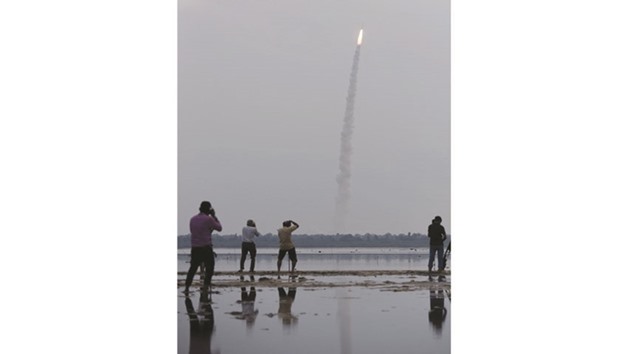India’s space agency yesterday inserted eight satellites into two different orbits in one of its most complex and longest missions.
A Polar Satellite Launch Vehicle (PSLV) rocket took off from the Sriharikota spaceport at 9.12am (0342 GMT) and placed the payloads in their prescribed orbits some two hours and 15 minutes later, Indian Space Research Organisation spokesman D P Karnik said.
Besides being a complex mission, it was also the space agency’s workhorse rocket, the PSLV’s, longest flight, he added.
Most countries launch satellites in a single orbit and even if multiple satellites are inserted, it is in sequence in the same orbit, NDTV news channel reported.
A twin-orbit manoeuvre was accomplished by the European Space Agency Vega rocket, it said.
“This is a challenging two-in-one mission which puts India in a unique league of nations having the capability to achieve two different orbits in a single mission,” ISRO chief A S Kiran Kumar said.
“Our scientists keep scripting history,” Prime Minister Narendra Modi wrote on Twitter.
While the main weather forecasting SCATSAT-1 satellite was placed in a 720km, two more satellites from India, three from Algeria and one each from Canada and the United States were inserted in a 670km orbit.
With this success, India has successfully launched 79 satellites for international customers.
Interestingly, this was also PSLV’s longest launch spread over two hours and 15 minutes.
ISRO also put into commercial use its multiple burn technology in PSLV. Simply put multiple burn technology is the switching off and on of a rocket’s engine in space mainly to deliver satellites in two different orbits.
Vikram Sarabhai Space Centre (VSSC) director K Sivan said: “The mission was exciting and the longest one. The other landmark mission to be done this year will be the GSLV-Mk 3 rocket.”
Exactly at 9.12am the PSLV rocket standing 44.4m tall and weighing 320 tonnes tore into the morning skies with fierce orange flames at its tail.
Gathering speed every second the rocket raced towards the heavens amidst the cheers of the ISRO officials and the media team assembled at the rocket port here.
At the rocket mission control room, the ISRO scientists were glued to their computer screens watching the rocket escaping the earth’s gravitational pull.
Seventeen minutes into the flight the rocket’s main cargo, the 371kg SCATSAT-1 - for ocean and weather related studies - was injected into a 730km polar sun synchronous orbit.
The remaining seven satellites were also placed in a 689km polar orbit after a long time lag.
Although SCATSAT-1 is a follow-on mission for Oceansat-2 improvements have been made in the satellite’s hardware configuration based on lessons learnt from Oceansat-2 instruments.
Also SCATSAT-1’s payload has been characterised with the objective of achieving data quality for Climate Data Records, apart from facilitating routine meteorological applications, the ISRO said.
The ISRO said, SCATSAT-1’s scatterometer will provide wind vector data products for weather forecasting, cyclone detection and tracking services to the users.
The satellite carries Ku-band scatterometer similar to the one flown onboard Oceansat-2.
The mission life of the satellite is five years.
After slinging SCATSAT-1 into its orbit the rocket’s fourth stage was restarted one hour 22 minutes into the flight and cut off around 20 seconds later. Two hours and 11 minutes into the flight the fourth stage was again restarted to be cut off one minute later.
Following that in three minutes all the seven satellites were ejected putting an end to PSLV’s longest mission till date.
The PSLV rocket is a four stage/engine rocket powered by solid and liquid fuel alternatively.
On Sunday, Sivan had said that the long time gap between the cutting off of the engine and its restart was not an issue.
The director said the multiple burn technology was first tested by ISRO while flying its PSLV rocket on December 16, 2015 and in June 2016, the technology was again demonstrated.
About the challenge, Sivan said: “After cutting off the engine, its condition should be brought to such a stage that it could be restarted again. The next challenge is to control the engine and bring it so as to eject the remaining satellites into a different orbit.”
He said the rocket has GPS aided navigation system so that data generated by the rocket’s inertial navigation system and the one provided by the former will be blended to erase errors and to generate a precise data.

People photograph the launch of the Indian Space Research Organisation (ISRO) Polar Satellite Launch Vehicle (PSLV-C35), carrying equipment which will be used to monitor oceans and weather at Sriharikota yesterday. The rocket also deployed satellites from Algeria, Canada and the US.
